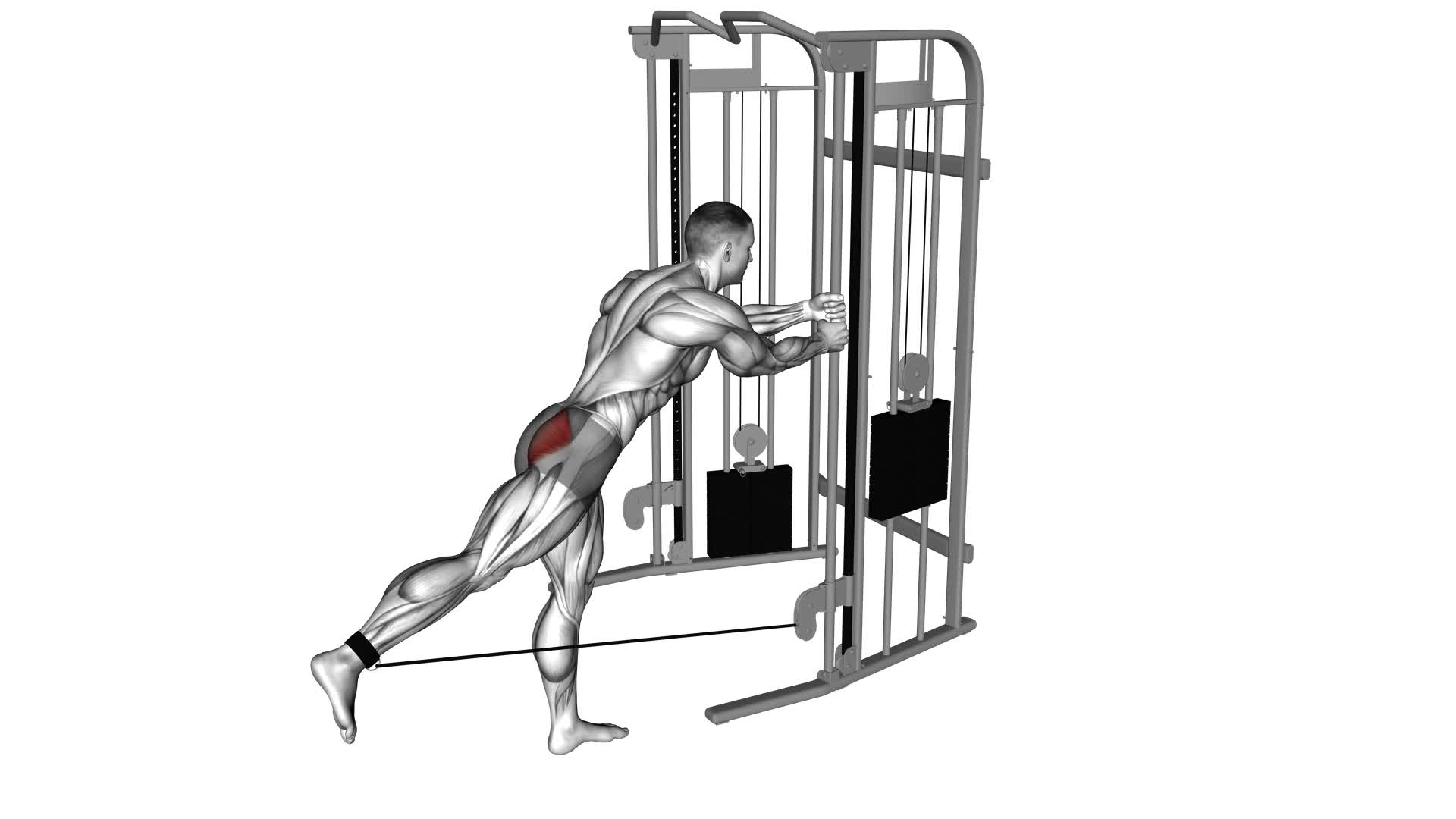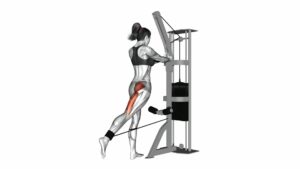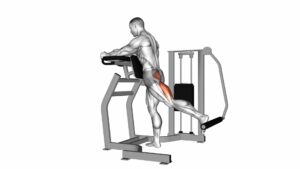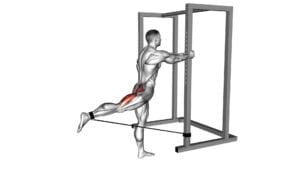Cable Standing Hip Extension – Video Exercise Guide & Tips

Are you looking to strengthen your hip muscles and improve your overall lower body strength? Look no further than the cable standing hip extension!
Watch This Exercise Video
In this video exercise guide, we'll show you the proper form and technique for this effective workout.
With variations and modifications to suit your fitness level, along with tips for maximizing your results, you'll be on your way to a stronger, more toned lower body in no time.
Let's get started!
Key Takeaways
- Cable standing hip extension targets and strengthens the muscles in the hips and glutes.
- It improves overall lower body strength and stability.
- Cable standing hip extension enhances balance and coordination.
- It helps prevent and alleviate hip pain and discomfort.
Benefits of Cable Standing Hip Extension
Improve your hip strength and stability with cable standing hip extension. This exercise offers numerous benefits and is a great addition to your workout routine.
One of the main benefits of cable standing hip extension is that it targets and strengthens the muscles in your hips and glutes. By engaging these muscles, you can improve your overall lower body strength and stability. This exercise also helps to improve your balance and coordination, as you have to maintain control throughout the movement.
Another benefit of cable standing hip extension is that it can help to prevent and alleviate hip pain and discomfort. By strengthening the muscles around your hips, you can provide better support to the joint and reduce the risk of injury. Additionally, this exercise can improve your posture and alignment, which can further alleviate hip pain.
To perform cable standing hip extension, attach the cable to your ankle and stand facing the machine. Keep your core engaged and brace your abs. Extend your leg behind you, squeezing your glutes at the top of the movement. Slowly return to the starting position and repeat for the desired number of reps.
Incorporating cable standing hip extensions into your workout routine can provide a range of benefits, including improved hip strength, stability, and decreased hip pain. Start incorporating this exercise into your routine today and enjoy the benefits it brings.
Equipment Needed for Cable Standing Hip Extension
To perform cable standing hip extension, you'll need a cable machine and an ankle attachment. These pieces of equipment are crucial for ensuring proper form and targeting the hip muscles effectively. The cable machine provides the resistance needed to challenge the hip muscles, while the ankle attachment allows you to attach the cable to your leg for a controlled movement.
When choosing a cable machine, look for one that has adjustable height and weight settings. This will allow you to customize the exercise to your fitness level and goals. The ankle attachment should be sturdy and secure, ensuring that it stays in place throughout the movement.
There are also variations of the cable standing hip extension that can be performed using different equipment. For example, you can use a resistance band instead of a cable machine if you don't have access to one. The resistance band can be anchored to a stable object, such as a door or pole, and attached to your ankle for the exercise.
Proper Form and Technique for Cable Standing Hip Extension
To perform cable standing hip extension with proper form and technique, you should focus on maintaining a stable stance and controlled movement throughout the exercise. Correct form is essential to target the right muscles and avoid injury.
Start by attaching the ankle cuff to your ankle and standing facing the cable machine. Position yourself far enough away from the machine so that there's tension on the cable when your leg is in the starting position. Place your hands on a stable surface for support.
Begin the exercise by extending your leg backward, keeping it straight and controlled. Avoid arching your back or leaning forward as you extend your leg. Engage your glutes and hamstrings to lift your leg as high as possible without compromising form. Pause for a moment at the top of the movement, then slowly lower your leg back to the starting position.
Common mistakes to avoid include using momentum to swing the leg, which reduces the effectiveness of the exercise. Make sure to control the movement throughout the entire range of motion. Another mistake is failing to maintain a stable stance. Keep your standing leg slightly bent and rooted to the ground, and avoid shifting your weight to one side.
Variations and Modifications for Cable Standing Hip Extension
To modify cable standing hip extension, you can adjust the resistance, change the starting position, or incorporate different equipment.
If you want to make the exercise more challenging, you can increase the weight on the cable machine or use a heavier resistance band. This will engage your hip muscles even more and help you build strength and stability. On the other hand, if you're just starting out or want to focus on technique, you can decrease the resistance or use a lighter band. This will allow you to perform the exercise with proper form and minimize the risk of injury.
Another way to modify cable standing hip extension is by changing the starting position. Instead of standing upright, you can try doing the exercise in a split stance or in a lunge position. This will target your hip muscles from different angles and activate different muscle fibers.
If you don't have access to a cable machine, there are alternative hip extension exercises you can do. One option is to use resistance bands or ankle weights to perform standing or lying hip extensions. Another option is to use a stability ball or a glute bridge machine to target your hip muscles. These exercises can be just as effective in strengthening your hips and improving your overall lower body strength.
Remember to always listen to your body and choose the modifications that work best for you. As you progress, you can gradually increase the resistance or try more advanced cable exercises to keep challenging your muscles.
Tips for Maximizing Your Cable Standing Hip Extension Workout
Maximize your cable standing hip extension workout with these tips.
To ensure you get the most out of your exercise routine, it's important to avoid common mistakes and progress gradually.
First, make sure you maintain proper form throughout the exercise. Keep your core engaged, shoulders relaxed, and back straight. Avoid arching your lower back or leaning excessively forward.
Another common mistake is using too much weight. Start with a lighter resistance and gradually increase as you become stronger and more comfortable with the movement.
It's also important to focus on the mind-muscle connection. Concentrate on squeezing your glutes at the top of the movement and controlling the descent. This will help you fully engage the hip muscles and maximize the effectiveness of the exercise.
As you progress, you can add variations to the cable standing hip extension. You can try different foot positions, such as wide stance or single-leg stance, to target different muscles and challenge your balance. Additionally, you can increase the intensity by using resistance bands or incorporating a stability ball.
Remember to listen to your body and adjust the workout according to your fitness level and goals.
Frequently Asked Questions
How Many Sets and Repetitions Should I Do for Cable Standing Hip Extension?
To progress in cable standing hip extension, you should start with a weight that challenges you but allows you to maintain good form.
Begin with 2 sets of 10-12 repetitions on each leg.
As you get stronger, gradually increase the weight and the number of sets and repetitions.
This exercise targets your glutes, hamstrings, and hip muscles, helping to improve your overall lower body strength and stability.
Plus, it can also enhance your athletic performance and prevent injuries.
Can I Perform Cable Standing Hip Extension With a Resistance Band Instead of a Cable Machine?
Yes, you can perform cable standing hip extension with a resistance band instead of a cable machine. Using a resistance band as an alternative provides similar benefits to the cable machine, such as strengthening your glute muscles.
To perform the exercise, secure the resistance band around a sturdy object and attach it to your ankle. Stand upright and extend your leg backward against the resistance of the band. Remember to maintain proper form and control throughout the movement.
Is Cable Standing Hip Extension Suitable for Beginners?
Yes, cable standing hip extension is suitable for beginners. It's a great exercise to strengthen your glutes and improve hip stability.
To start, stand facing a cable machine with your feet shoulder-width apart. Attach the ankle strap to your right ankle and grab the handle with your left hand for support.
Slowly extend your right leg back while keeping your back straight. Avoid arching your back or leaning forward.
This variation helps target the glute muscles and corrects common mistakes.
Can Cable Standing Hip Extension Help Improve My Balance?
Cable standing hip extension is a great exercise for improving stability and balance. By targeting the hip muscles, it helps you develop strength and control in that area.
The benefits of cable exercises, like this one, include increased muscle activation and improved coordination. Incorporating this exercise into your routine can help you enhance your overall balance and stability, making everyday activities and sports performance easier and more efficient.
Are There Any Precautions or Contraindications for Cable Standing Hip Extension?
Before attempting cable standing hip extension, it's important to be aware of any precautions or contraindications.
Precautions may include having a stable base of support and proper form to avoid injury.
Contraindications may include certain medical conditions or injuries that could be exacerbated by this exercise.
Always consult with a healthcare professional or certified trainer before beginning any new exercise program to ensure it's safe and appropriate for you.
Conclusion
In conclusion, cable standing hip extension is a highly effective exercise for strengthening and toning the hip muscles. By using the cable machine, you can target these muscles in a controlled and precise manner.
Remember to maintain proper form and technique throughout the exercise, and feel free to modify or vary the exercise to suit your fitness level.
With consistent practice and attention to detail, you can maximize the benefits of cable standing hip extension in your workout routine.

Author
Years ago, the spark of my life’s passion ignited in my mind the moment I stepped into the local gym for the first time. The inaugural bead of perspiration, the initial endeavor, the very first surge of endorphins, and a sense of pride that washed over me post-workout marked the beginning of my deep-seated interest in strength sports, fitness, and sports nutrition. This very curiosity blossomed rapidly into a profound fascination, propelling me to earn a Master’s degree in Physical Education from the Academy of Physical Education in Krakow, followed by a Sports Manager diploma from the Jagiellonian University. My journey of growth led me to gain more specialized qualifications, such as being a certified personal trainer with a focus on sports dietetics, a lifeguard, and an instructor for wellness and corrective gymnastics. Theoretical knowledge paired seamlessly with practical experience, reinforcing my belief that the transformation of individuals under my guidance was also a reflection of my personal growth. This belief holds true even today. Each day, I strive to push the boundaries and explore new realms. These realms gently elevate me to greater heights. The unique combination of passion for my field and the continuous quest for growth fuels my drive to break new ground.







